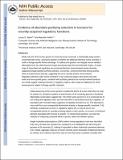| dc.contributor.author | Ward, Lucas D. | |
| dc.contributor.author | Kellis, Manolis | |
| dc.date.accessioned | 2016-01-06T17:21:37Z | |
| dc.date.available | 2016-01-06T17:21:37Z | |
| dc.date.issued | 2012-09 | |
| dc.date.submitted | 2012-05 | |
| dc.identifier.issn | 0036-8075 | |
| dc.identifier.issn | 1095-9203 | |
| dc.identifier.uri | http://hdl.handle.net/1721.1/100727 | |
| dc.description.abstract | Although only 5% of the human genome is conserved across mammals, a substantially larger portion is biochemically active, raising the question of whether the additional elements evolve neutrally or confer a lineage-specific fitness advantage. To address this question, we integrate human variation information from the 1000 Genomes Project and activity data from the ENCODE Project. A broad range of transcribed and regulatory nonconserved elements show decreased human diversity, suggesting lineage-specific purifying selection. Conversely, conserved elements lacking activity show increased human diversity, suggesting that some recently became nonfunctional. Regulatory elements under human constraint in nonconserved regions were found near color vision and nerve-growth genes, consistent with purifying selection for recently evolved functions. Our results suggest continued turnover in regulatory regions, with at least an additional 4% of the human genome subject to lineage-specific constraint. | en_US |
| dc.description.sponsorship | National Institutes of Health (U.S.) (Grant R01HG004037) | en_US |
| dc.description.sponsorship | National Institutes of Health (U.S.) (Grant RC1HG005334) | en_US |
| dc.description.sponsorship | National Science Foundation (U.S.) (CAREER Grant 0644282) | en_US |
| dc.language.iso | en_US | |
| dc.publisher | American Association for the Advancement of Science (AAAS) | en_US |
| dc.relation.isversionof | http://dx.doi.org/10.1126/science.1225057 | en_US |
| dc.rights | Article is made available in accordance with the publisher's policy and may be subject to US copyright law. Please refer to the publisher's site for terms of use. | en_US |
| dc.source | PMC | en_US |
| dc.title | Evidence of Abundant Purifying Selection in Humans for Recently Acquired Regulatory Functions | en_US |
| dc.type | Article | en_US |
| dc.identifier.citation | Ward, L. D., and M. Kellis. “Evidence of Abundant Purifying Selection in Humans for Recently Acquired Regulatory Functions.” Science 337, no. 6102 (September 5, 2012): 1675–1678. | en_US |
| dc.contributor.department | Massachusetts Institute of Technology. Computer Science and Artificial Intelligence Laboratory | en_US |
| dc.contributor.department | Massachusetts Institute of Technology. Department of Electrical Engineering and Computer Science | en_US |
| dc.contributor.mitauthor | Ward, Lucas D. | en_US |
| dc.contributor.mitauthor | Kellis, Manolis | en_US |
| dc.relation.journal | Science | en_US |
| dc.eprint.version | Author's final manuscript | en_US |
| dc.type.uri | http://purl.org/eprint/type/JournalArticle | en_US |
| eprint.status | http://purl.org/eprint/status/PeerReviewed | en_US |
| dspace.orderedauthors | Ward, L. D.; Kellis, M. | en_US |
| dc.identifier.orcid | https://orcid.org/0000-0002-8017-809X | |
| mit.license | PUBLISHER_POLICY | en_US |
